QuestionA few months ago I about a baby budgie for my son from a pet store. I've since learned the experts call this a "budgie bin" and isn't the best place to get a bird that will easily tame.
I was hoping he would talk but I can't even get him to my finger. I read someplace that I should not let him out of the cage until he's finger tame, but that might be forever. I also read he won't talk until he's finger tame.
Is it okay to let him out of the cage to fly around? And how do I tame this poor skittish guy? He does not bite--he just backs up and climbs the wall of his cage. I've tried perch-training him, thinking an extra perch would be friendlier to put in his cage before my finger, but that doesn't work either. I can't go much slower with him than I'm going.
He's healthy and very chirpy. He bobs his head and sings his heart out. Should I give up on ever finger-taming him or teaching him to talk? He seems happy. But shouldn't I be letting him fly around sometimes?
Thanks. Linda
AnswerHi, Linda. Thanks for posting.
I'll give you some general information on parrots/budgies first, then answer your specific questions and provide some advice on how you can start to tame your budgie.
Taming a parrot (your budgie is a parrot) has to begin long before purchasing the bird. The tamest parrots are those who are pulled from their parents before their eyes open, or shortly thereafter, and handfed by the breeder with a handfeeding syringe and baby bird formula until they are weaned. This ensures the baby parrot is imprinted on humans. The later this imprinting is attempted, the harder it is to tame the bird (depending on the individual bird). Even parrots who have been handfed can lose some of their tameness once they are weaned and placed up for sale if the daily human interaction is no longer present, particularly if the bird is placed in a situation (such as a "budgie bin") where other birds are present. This is because birds prefer other birds to humans. Making matters worse, when parrots are for sale in a pet shop or other place where anyone can poke/prod them all day long, they tend to become leary and fearful of fingers/hands/people in general (not all people are "nice" to pets on display). If your budgie was not handfed as a baby, then put up for sale in a pet store, it has 2 strikes against it already! The best way to buy a pet parrot is from a breeder who handfeds the babies as early as possible and offers them for sale as soon as they are weaned.
Male budgies can learn to talk, but it is fairly rare. I've only had 2 budgies who talked in the 16+ years I've been breeding budgies/parakeets, and I've raised/kept hundreds of them. All parrots have the ability to talk, but whether they will or not depends on each individual bird and your skills in teaching them. Parrots don't actually talk, they mimic with their throat what they hear and only if they choose to do so. There are no guarantees. Talking and finger tameness have nothing to do with each other. Parrots can be completely tame and never talk and they can talk and never be tame!
You can certainly let him out of his cage to fly around if you want to, but you will most likely have trouble catching him when you want him back in his cage. This might be why you read that they should be finger tame before letting them fly around. Certainly, the best way for your budgie to get sufficient exercise is to let him fly around your home, but this can cause other problems. Your budgie can injure (or even kill) himself by flying into walls, by flying onto lit/hot stoves, flying into commodes/sinks full of water, right out your front door or through an open window, etc., not to mention the potential mess of droppings. Parrots don't have to fly outside their cages in order to get exercise. As long as a parrot can flap it's wings vigorously inside it's cage without it's wings touching any sides, top, or bottom cage wire or toys, feed/water dishes, etc., it can get enough exercise. The ideal cage situation is one in which a parrot's cage is large enough so that it can fly horizontally (back and forth) inside it's cage without it's wings/body touching anything inside it's cage (parrots don't fly vertically).
Since I don't know if your budgie was handfed as a baby, you'll need to start from scratch with your budgie. The first thing you should do is to have it's wings clipped. This is not cruel nor hurts the bird. Some people think clipping the wings is unnatural, but so is caging a parrot. If done properly, there is no pain...it's like clipping your fingernails...no feeling at all. What this does is forces your budgie to become dependent upon you for mobility, i.e., it will not be able to get from point A to point B without your help. It also keeps your budgie safe from household injuries (mentioned above). Your budgie will still be able to flap it's wings for exercise, but just won't have as many feathers to flap when he does this (flapping the wings exercises muscles in the back and chest)! You may not want to clip your budgie if you also own cats/dogs. If your budgie would happen to get down from his cage, he'll need to fly in order to get away from the other pets. In this case, you'll need to move your budgie to a different room in your home where the other pets can't get to him and/or keep your budgie locked in his cage when the other pets are present.
Once it's wings are clipped (both wings, not just one side), you'll need to give your budgie some time (varies with each individual bird) to get used to not being able to gain altitude when he flaps his wings. In other words, the first time he tries to fly after being clipped, he'll probably fall to the floor or gently glide downward, but not upward (if he gains altitude after clipping, not enough wing feathers were clipped). Since he doesn't bite, what you need to do is place your finger to his lower chest just above the top of his legs and gently push in at this area saying "up" or "step up" at the same time. This should force him to step up onto your finger. If he does step up onto your finger, you MUST reward him in some manner, i.e., give him his favorate treat immediately. ALWAYS reward positive behavior and NEVER reward negative behavior. In other words, when he does what you want, reward him immediately. When he doesn't, ignore him completely. This teaches him right from wrong.
If he doesn't cooperate by stepping up on your finger, then I recommend you take him into a neutral room and work with him as often as possible each day. A neutral room is a room where he can't see nor get to his cage and one in which there are minimal distractions. If he can get to his cage (which is his safety zone), he'll always go for it when he wants to. You have to have a bird's complete attention in order to work with them. When you've lost his attention, stop the training session and start again later. Some sessions may only last a couple minutes, some might last 5 minutes or more, depending on what's going on at the time. Once in a neutral room, place your budgie down on the floor or on a bed or couch and just play with him, interact with him, talk with him, etc. Try getting him to step up on your finger/hand/arm. Just get used to each other. Your goal is to build up trust between yourself and your budgie. If a parrot doesn't trust you, you can't do anything with them, they will fear you. Also, if/when he tries to bite/lunge at you, don't pull back. When you pull back, you are actually teaching him that if he bites/lunges, you will leave him alone, which is EXACTLY what he wants you to do. Do the exact opposite. You may get biten occasionally, but it only hurts for a little bit and you are teaching your budgie so much! Remember to always reward for positive behavior. This is similar to giving human children dessert if they have eaten all their dinner!
Another way you can start the taming process is to allow your budgie to come out of his cage by himself after his wings are clipped. Leave his cage door open and coax/allow him to come out on his own. Once he starts coming out on his own, start interacting with him gradually. When he happens to fly/fall off his cage, use this to your benefit by "asking" him to "step up" onto your finger...actually try to force him to step up onto your finger, making this the only way he can get back onto his cage (with his wings clipped, he'll soon learn your finger is his best way to get there). A parrot's cage is it's safety zone, it's personal space, it's personal territory. Most parrots do not appreciate their humans intruding into their personal space. I've had most of my parrots for over 10 years and most still do not like me intruding into their cages. I have to service their cages and they let me do this, but they don't especially appreciate me messing with their stuff! They let me in peacefully if I have a dish of food for them!
Taming a parrot takes time, so don't think this will happen overnight. The amount of time depends on what has happened in the bird's life up to now, his personal characteristics, and your skills as a teacher.
My website might provide you with more useful information if you want to visit: http://www.angelfire.com/falcon/birdinfo/index.html
Come back if you need to. Thanks.
Chrys

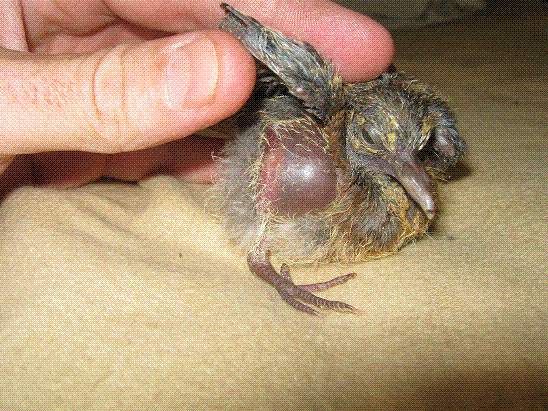 Baby Pigeon
Question
Cosmo
Hi Roger
We picked up a baby pigeon, ap
Baby Pigeon
Question
Cosmo
Hi Roger
We picked up a baby pigeon, ap
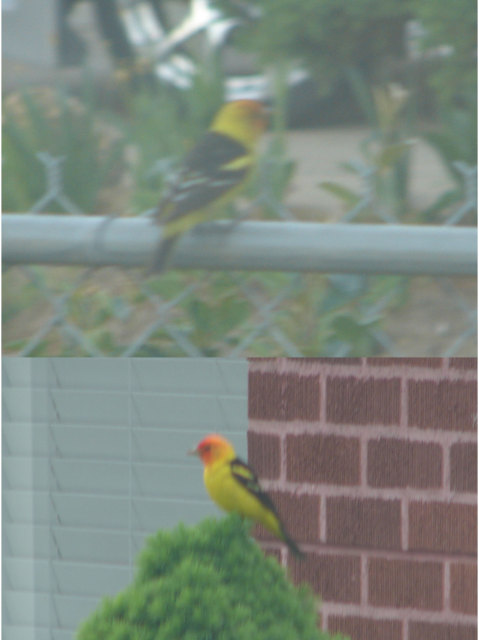 Wild or Domestic?
Question
Pretty Birds
There are these three birds in my
Wild or Domestic?
Question
Pretty Birds
There are these three birds in my
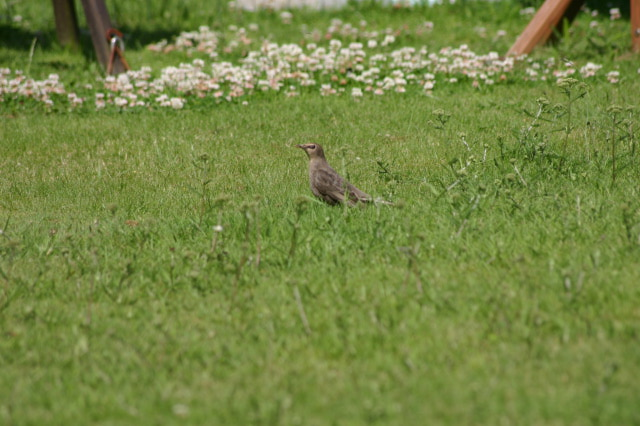 Identification of a bird
Question
Bird name
Please can you advise what th
Identification of a bird
Question
Bird name
Please can you advise what th
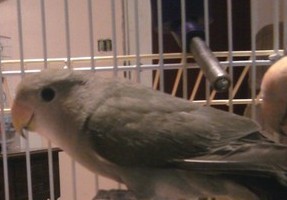 My odd lovebird
Question
Honey
I have a love bird that is approximately
My odd lovebird
Question
Honey
I have a love bird that is approximately
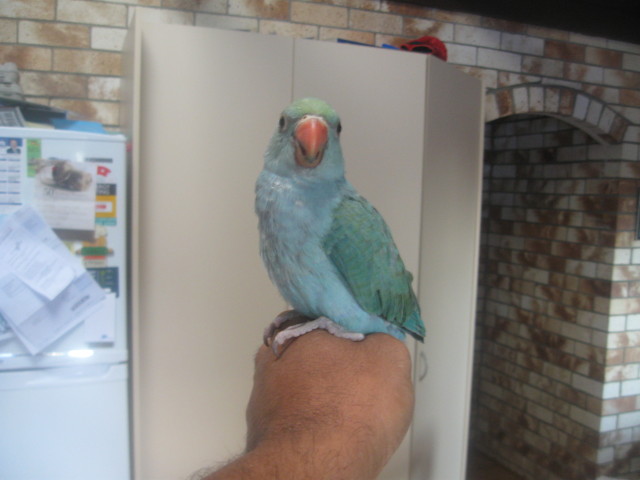 Color of my indian ringneck
Question
Boots
I have an eleven week old male ringneck
Color of my indian ringneck
Question
Boots
I have an eleven week old male ringneck